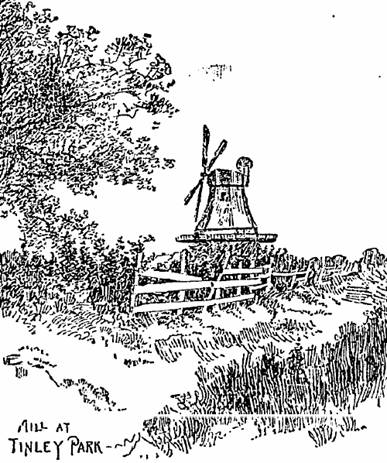ILLINOIS WINDMILLS
Dedicated to the history, preservation, and continuing story of windmills in Illinois.

Bartels Windmill
New Bremen Mill, Old Windmill
Oak Park Ave and 171st St
Tinley Park, IL 60477
Status
Destroyed by owner, 1911
Tower Height
63' (approximate)
Sail Span
75' (approximate)
Uses
(1873 - 1892) Wheat
(1872 - 1892) Corn
Constructed
(1869 - 1873)
Millwrights
George Bartels
Earnest Papa
Owners
George Bartels (1869 - ?)
Earnest Papa (1869 - ?)
Mr. Johnson (? - ?)
John Hartman (? - ?)
Hans Hartman (? - 1911)

The Bartels Windmill
Sources
-
Golz, Jennifer. “Tinley’s Windmill and other Eclectic Pieces of the Past Preserved at Museum.” The Star. April 20, 2006.
-
Tinley Park Public Library
-
Tinley Park Historical Society
Historic Photographs
 |
|---|
 |
 |
 |
 |
 |
 |
 |
 |
 |
 |
 |
History of the Mill
In 1850, Hanover, Germany immigrant George Bartels (note: Bartels, Bartells, and Bartles are all used in historical texts. The Tinley Park Historical Society uses Bartels in its publications) and his family established a farm and homestead on 80 acres that covered the area northeast of the intersection of Oak Park Avenue and 171st Street. With the nearest mills miles away (cited are Fischer’s, Rathje’s, and a wind grist mill in Dyer, IN), it was decided in the 1860s to construct a mill in Tinley Park (then New Bremen).
Construction began late in 1869 and was completed by early 1873 at a cost of $10,000. No sources reference why construction of the mill took so long. One source mentions that at the time of the mill’s demolition, building materials were hard to come by; if the mill was built using local resources, perhaps building materials were also hard to locate for its construction.
It seems that some arguing took place about the mill’s size. Herb Moss—who helped to dismantle the mill in 1911—claims that each sail was 8’ wide and 75’ long. But for this to have been true, the mill’s tower would have been over 100’ tall, and would have been even larger than the Murphy Windmill in Golden Gate Park.
By photographs of the mill, it is clear that the windmill had a 75’ diameter sail span, which is a typical length. Moss may have been correct, however, about Bartels’ mill being the largest, as it was six stories high with a basement. Taking the mill’s recorded overall height of 100’ and subtracting the sail length would make the tower about 63’ tall—definitely among the tallest in Illinois until Fabyan added a basement to his relocated windmill.
The mill followed a German-influenced design. It included a tail-fan to automatically turn the cap; three run-of-stone, constructed in sections with marble; and modern shelling and wheat-cleaning machines. It was also equipped with a simple sack hoist for transporting grain to the upper levels of the mill.
The mill was doing fine business, even as it was passed down to several owners. In 1911 when it became property of Hans Hartman, the son-in-law of George Bartels, steam-powered roller mills rendered the dilapidated windmill useless. The mill was dismantled in pieces: its lumber was used to build homes; its metal went to the local blacksmith; and the stones were left on the ground to weather away.
Years later, the Tinley Park Historical Society recovered pieces of a mill stone, which are now on display at their museum. In 1991, they honored the windmill with its image on a Christmas ornament. Tinley Park High School student David Fulton also built a very detailed and, by all accounts, very accurate, model of the windmill.
A 7-11 convenient store now sits on the street corner where the windmill once stood.